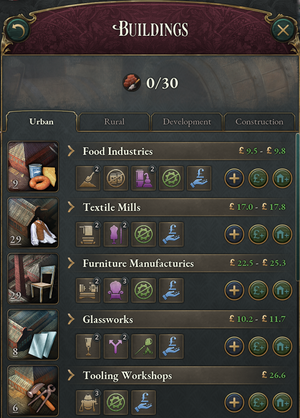无编辑摘要 |
|||
| 第1行: | 第1行: | ||
{{Version|pre-release}} | {{Version|pre-release}} | ||
{{see also|List of production methods}} | {{see also|List of production methods}} | ||
[[File:UI buildings.png|thumb| | [[File:UI buildings.png|thumb| 建筑物面板提供了国家的建筑物及其相关生产方式的详细摘要。]] | ||
生产方式决定了建筑物的功能、投入品和产出品,以及所需的就业者类型。 | |||
在维多利亚3中,所有行动都会带来反馈,因此创新并非单纯对建筑物有利,不带来副作用。随着时间的推移的确应该逐步改进工业流程,但在某些情况下,这些改进可能需要一些稀缺的投入品,还有的时候会得到新的产出品,而降低原来的产出。因此,维多利亚3的建筑需要更灵活的升级路径,不是永久性的、线性的、" 不费吹灰之力 " 的改进。 | |||
== | == 生产方式类型 == | ||
所有建筑都有几类生产方式,通常在2至5之间。每个类别中只能同时启用一种生产方式。 | |||
大多数生产方式属于以下类别: | |||
* '' | * '' 基础——'' 管理建筑的总体“科技水平”和效率,生产该建筑类型的典型商品。 | ||
* '' | * '' 改进'' ——减少典型商品的产出,增加专门或奢侈商品的产出,有时需要引入额外的投入品。 | ||
* '' | * '' 自动化'' ——增加工业品作为投入以减少建筑对非熟练劳动力的需求。 | ||
* '' | * '' 所有权'' ——决定谁拥有建筑物的股份;通常由法律规定。 | ||
== | == 铁矿实例 == | ||
以'' 铁矿'' 建筑为例,了解不同生产方式间的区别: | |||
* | * 基础生产方式——决定了矿工是只使用镐和铲子,还是也使用某种发动机驱动的泵送机制。存在几种不同的泵送科技,使用不同的燃料。泵送机制越先进,可以开采的矿藏就越多,生产{{icon|iron|21px}} 铁的效率也就越高,但在这个过程中使用的煤炭或油也就越多。随着泵的技术含量越来越高,需要更多的{{icon|engineers|21px}} 工程师和{{icon|machinists|21px}} 技工在现场监督和控制其运行。这创造了对有资质工人的更多需求,也为那些符合资质的人群提供了一些薪水更高的职位。 | ||
* | * 二级生产方式(只适用于矿井)——这个时代的化学革命使{{icon|explosives|21px}} 炸药得以在采矿中使用。 发明硝化甘油后,炸药就可以用在矿井中,消耗化学工业生产的炸药来生产更多的矿物。然而,这样做也导致了更高的工作场所事故率。通过研究挥发性较低的炸药,可以消耗更多的炸药,开采出更多的矿物,还有一个额外的好处,就是不会再有工人在工作中炸死自己。 | ||
* | * 自动化生产方式——经发明,便携式蒸汽辅助发动机就可部署在采矿现场,大幅减少仅用于牵引的人工劳动量。这会让建筑花费一笔钱来购买煤炭和发动机,但减少了需要支付的工资数量。也许更重要的是,如果该地区的{{icon|laborers|21px}} 劳工数量不足,它可以释放这些劳工,让他们到其他建筑中去工作。但需要注意的是,如果工资已经非常低迷,而仍然去购买昂贵的工业品,只是为了进一步增加没有资质的劳动力储备,可能不是一个好主意。 | ||
* | * 所有权生产方式——在大多数国家,简单的矿井在游戏开始时由商人行会拥有和经营。这些是以{{icon|shopkeepers|21px}} 店主为代表的的小型商品供应商。当矿井开始工业化时,{{icon|capitalists|21px}} 资本家将介入,接管所有权。在大多数情况下,这些资本家将来自于被提拔到这些新设立的职位的店主,但有些人可能来自于该地区的其他人群,甚至是来自其他建筑的资本家,他们原来的建筑不像这些新矿井那样有利可图。虽然资本家人数较少,但他们的工资比店主高,更重要的是,他们会根据工作场所为他们创造的利润多少,将部分收入再投资到国家正在扩张的工业中。随着新思想在社会上的传播,你也许可以让采矿业公开交易,而不是私人持有,在游戏的后期,甚至可以将其国有化,由政府官僚管理,或者将其变成合作社,利润由工人共享。 | ||
== | == 管理生产方式 == | ||
玩家可以通过建筑面板快捷管理国家所有的建筑及其相关生产方式。 | |||
该面板提供了全国所有行业的鸟瞰图,一目了然地看到它们的财务状况。建筑按主要类型和次要类型分类,可进一步打开查看单个地区的单独建筑,还可点击进入建筑,深入了解其资产负债表和劳动力情况。此外,该面板允许单独或批量地调整建筑的生产方式。 | |||
预测工具提示将解释由于生产、消费和工资要求的变化而对建筑结余的预期影响,以及就业的变化(新增或减少消失的就业岗位),这也会随着时间的推移影响国家的政治。如果有新创造的职业雇不到足够的有资质人群,就会发出警告,因为这会限制建筑的效率。 | |||
== 社会影响 == | |||
生产方式并不限于消费和生产商品。政府行政部门雇用官僚和职员,他们使用纸张,产出{{icon|bureaucracy|21px}}行政力,这是游戏的能力之一,让政府治理更多的人,并向他们提供更多的国家服务。铁路消费发动机和燃料(如煤炭)来生产运力和[[infrastructure|基础设施]],前者在市场上出售,后者能在地区[[market access|市场接入度]]不下降的情况下建造更多的建筑。大学雇佣的{{icon|academics|21px}}学者让国家指导新技术和新思想的研究和发展。几乎所有类型的货币、修正或效果都可以由建筑物的生产方式产出,并可以以各种方式应用于国家、地区甚至建筑物本身。 | |||
== | 虽然从表面上看,毫无疑问应当启用能使建筑物更有利可图的生产方式,但玩家应该记住这些生产方式可能在不经意间造成社会影响。在选择一种生产方式的时候,人们可能需要思考一些问题。 | ||
一些可能的问题示例: | |||
* 本地区是否有足够的有资质人群从事新工艺所需的更高级工作? | |||
* 新工作的工资是否足以吸引这些人群更换职业? | |||
* 这样做是否会无意中创造出一个全新的富裕的技工阶层,有亲劳工的工会情绪? | |||
* 增加的利润是否能提高工人的工资,考虑到当前工资已经足够有竞争力并且建筑充分就业? | |||
* 这是否会简单地导致股东获得更多红利,而这些红利将被用于增加奢侈品消费? | |||
* 你是否能够自己供应这些奢侈品,而不是从你的宿敌那里进口它们,给他们带来利润? | |||
* 等等…… | |||
选择哪种方式可能取决于人口的社会流动性,国家的政治倾向(社会主义起义可能不是一个理想的结果),以及最终外国势力是否会从这些选择中比玩家受益更多。更有利可图的国内产业从来都不是坏事,但在建设社会时远远不是唯一的考虑。 | |||
== 参考资料 == | |||
<references/> | <references/> | ||
[[Category:经济]] | [[Category:经济]] | ||
[[en:Production method]] | [[en:Production method]] | ||
2022年12月2日 (五) 21:49的版本
生产方式决定了建筑物的功能、投入品和产出品,以及所需的就业者类型。
在维多利亚3中,所有行动都会带来反馈,因此创新并非单纯对建筑物有利,不带来副作用。随着时间的推移的确应该逐步改进工业流程,但在某些情况下,这些改进可能需要一些稀缺的投入品,还有的时候会得到新的产出品,而降低原来的产出。因此,维多利亚3的建筑需要更灵活的升级路径,不是永久性的、线性的、"不费吹灰之力 "的改进。
生产方式类型
所有建筑都有几类生产方式,通常在2至5之间。每个类别中只能同时启用一种生产方式。
大多数生产方式属于以下类别:
- 基础——管理建筑的总体“科技水平”和效率,生产该建筑类型的典型商品。
- 改进——减少典型商品的产出,增加专门或奢侈商品的产出,有时需要引入额外的投入品。
- 自动化——增加工业品作为投入以减少建筑对非熟练劳动力的需求。
- 所有权——决定谁拥有建筑物的股份;通常由法律规定。
铁矿实例
以铁矿建筑为例,了解不同生产方式间的区别:
- 基础生产方式——决定了矿工是只使用镐和铲子,还是也使用某种发动机驱动的泵送机制。存在几种不同的泵送科技,使用不同的燃料。泵送机制越先进,可以开采的矿藏就越多,生产
 铁的效率也就越高,但在这个过程中使用的煤炭或油也就越多。随着泵的技术含量越来越高,需要更多的
铁的效率也就越高,但在这个过程中使用的煤炭或油也就越多。随着泵的技术含量越来越高,需要更多的 工程师和
工程师和 技工在现场监督和控制其运行。这创造了对有资质工人的更多需求,也为那些符合资质的人群提供了一些薪水更高的职位。
技工在现场监督和控制其运行。这创造了对有资质工人的更多需求,也为那些符合资质的人群提供了一些薪水更高的职位。
- 二级生产方式(只适用于矿井)——这个时代的化学革命使
 炸药得以在采矿中使用。 发明硝化甘油后,炸药就可以用在矿井中,消耗化学工业生产的炸药来生产更多的矿物。然而,这样做也导致了更高的工作场所事故率。通过研究挥发性较低的炸药,可以消耗更多的炸药,开采出更多的矿物,还有一个额外的好处,就是不会再有工人在工作中炸死自己。
炸药得以在采矿中使用。 发明硝化甘油后,炸药就可以用在矿井中,消耗化学工业生产的炸药来生产更多的矿物。然而,这样做也导致了更高的工作场所事故率。通过研究挥发性较低的炸药,可以消耗更多的炸药,开采出更多的矿物,还有一个额外的好处,就是不会再有工人在工作中炸死自己。
- 自动化生产方式——经发明,便携式蒸汽辅助发动机就可部署在采矿现场,大幅减少仅用于牵引的人工劳动量。这会让建筑花费一笔钱来购买煤炭和发动机,但减少了需要支付的工资数量。也许更重要的是,如果该地区的
 劳工数量不足,它可以释放这些劳工,让他们到其他建筑中去工作。但需要注意的是,如果工资已经非常低迷,而仍然去购买昂贵的工业品,只是为了进一步增加没有资质的劳动力储备,可能不是一个好主意。
劳工数量不足,它可以释放这些劳工,让他们到其他建筑中去工作。但需要注意的是,如果工资已经非常低迷,而仍然去购买昂贵的工业品,只是为了进一步增加没有资质的劳动力储备,可能不是一个好主意。
- 所有权生产方式——在大多数国家,简单的矿井在游戏开始时由商人行会拥有和经营。这些是以
 店主为代表的的小型商品供应商。当矿井开始工业化时,
店主为代表的的小型商品供应商。当矿井开始工业化时, 资本家将介入,接管所有权。在大多数情况下,这些资本家将来自于被提拔到这些新设立的职位的店主,但有些人可能来自于该地区的其他人群,甚至是来自其他建筑的资本家,他们原来的建筑不像这些新矿井那样有利可图。虽然资本家人数较少,但他们的工资比店主高,更重要的是,他们会根据工作场所为他们创造的利润多少,将部分收入再投资到国家正在扩张的工业中。随着新思想在社会上的传播,你也许可以让采矿业公开交易,而不是私人持有,在游戏的后期,甚至可以将其国有化,由政府官僚管理,或者将其变成合作社,利润由工人共享。
资本家将介入,接管所有权。在大多数情况下,这些资本家将来自于被提拔到这些新设立的职位的店主,但有些人可能来自于该地区的其他人群,甚至是来自其他建筑的资本家,他们原来的建筑不像这些新矿井那样有利可图。虽然资本家人数较少,但他们的工资比店主高,更重要的是,他们会根据工作场所为他们创造的利润多少,将部分收入再投资到国家正在扩张的工业中。随着新思想在社会上的传播,你也许可以让采矿业公开交易,而不是私人持有,在游戏的后期,甚至可以将其国有化,由政府官僚管理,或者将其变成合作社,利润由工人共享。
管理生产方式
玩家可以通过建筑面板快捷管理国家所有的建筑及其相关生产方式。
该面板提供了全国所有行业的鸟瞰图,一目了然地看到它们的财务状况。建筑按主要类型和次要类型分类,可进一步打开查看单个地区的单独建筑,还可点击进入建筑,深入了解其资产负债表和劳动力情况。此外,该面板允许单独或批量地调整建筑的生产方式。
预测工具提示将解释由于生产、消费和工资要求的变化而对建筑结余的预期影响,以及就业的变化(新增或减少消失的就业岗位),这也会随着时间的推移影响国家的政治。如果有新创造的职业雇不到足够的有资质人群,就会发出警告,因为这会限制建筑的效率。
社会影响
生产方式并不限于消费和生产商品。政府行政部门雇用官僚和职员,他们使用纸张,产出![]() 行政力,这是游戏的能力之一,让政府治理更多的人,并向他们提供更多的国家服务。铁路消费发动机和燃料(如煤炭)来生产运力和基础设施,前者在市场上出售,后者能在地区市场接入度不下降的情况下建造更多的建筑。大学雇佣的
行政力,这是游戏的能力之一,让政府治理更多的人,并向他们提供更多的国家服务。铁路消费发动机和燃料(如煤炭)来生产运力和基础设施,前者在市场上出售,后者能在地区市场接入度不下降的情况下建造更多的建筑。大学雇佣的![]() 学者让国家指导新技术和新思想的研究和发展。几乎所有类型的货币、修正或效果都可以由建筑物的生产方式产出,并可以以各种方式应用于国家、地区甚至建筑物本身。
学者让国家指导新技术和新思想的研究和发展。几乎所有类型的货币、修正或效果都可以由建筑物的生产方式产出,并可以以各种方式应用于国家、地区甚至建筑物本身。
虽然从表面上看,毫无疑问应当启用能使建筑物更有利可图的生产方式,但玩家应该记住这些生产方式可能在不经意间造成社会影响。在选择一种生产方式的时候,人们可能需要思考一些问题。
一些可能的问题示例:
- 本地区是否有足够的有资质人群从事新工艺所需的更高级工作?
- 新工作的工资是否足以吸引这些人群更换职业?
- 这样做是否会无意中创造出一个全新的富裕的技工阶层,有亲劳工的工会情绪?
- 增加的利润是否能提高工人的工资,考虑到当前工资已经足够有竞争力并且建筑充分就业?
- 这是否会简单地导致股东获得更多红利,而这些红利将被用于增加奢侈品消费?
- 你是否能够自己供应这些奢侈品,而不是从你的宿敌那里进口它们,给他们带来利润?
- 等等……
选择哪种方式可能取决于人口的社会流动性,国家的政治倾向(社会主义起义可能不是一个理想的结果),以及最终外国势力是否会从这些选择中比玩家受益更多。更有利可图的国内产业从来都不是坏事,但在建设社会时远远不是唯一的考虑。
